University Financial Accounting Assignment: Consolidation and Analysis
VerifiedAdded on 2023/01/18
|12
|1333
|1
Homework Assignment
AI Summary
This document presents a comprehensive solution to a financial accounting assignment focusing on consolidation principles and accounting requirements. The assignment includes detailed analyses of acquisitions, specifically examining Smart Ltd and Positive Ltd. It involves preparing worksheet entries and consolidated financial statements, including balance sheets and income statements. The solution also addresses the complexities of intercompany transactions, such as the sale of inventory and plant assets, and their impact on consolidated figures. Furthermore, the assignment explores the consolidation of Ping Pong Ltd and Sing Song Ltd, covering similar aspects of worksheet entries, sales, cost of sales, and other expenses. The solution provides a step-by-step approach to ensure accurate financial reporting and compliance with accounting standards.
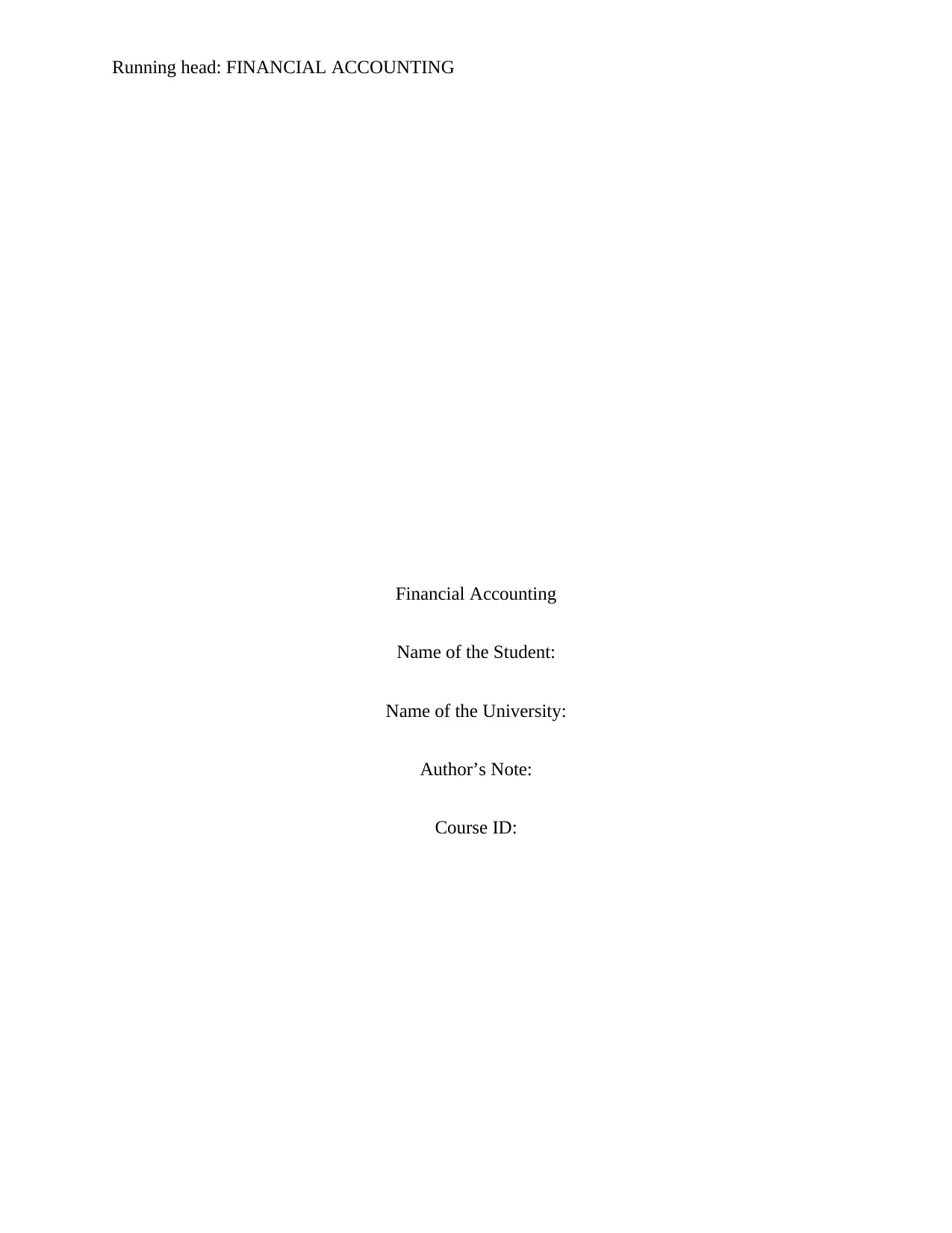
Running head: FINANCIAL ACCOUNTING
Financial Accounting
Name of the Student:
Name of the University:
Author’s Note:
Course ID:
Financial Accounting
Name of the Student:
Name of the University:
Author’s Note:
Course ID:
Paraphrase This Document
Need a fresh take? Get an instant paraphrase of this document with our AI Paraphraser
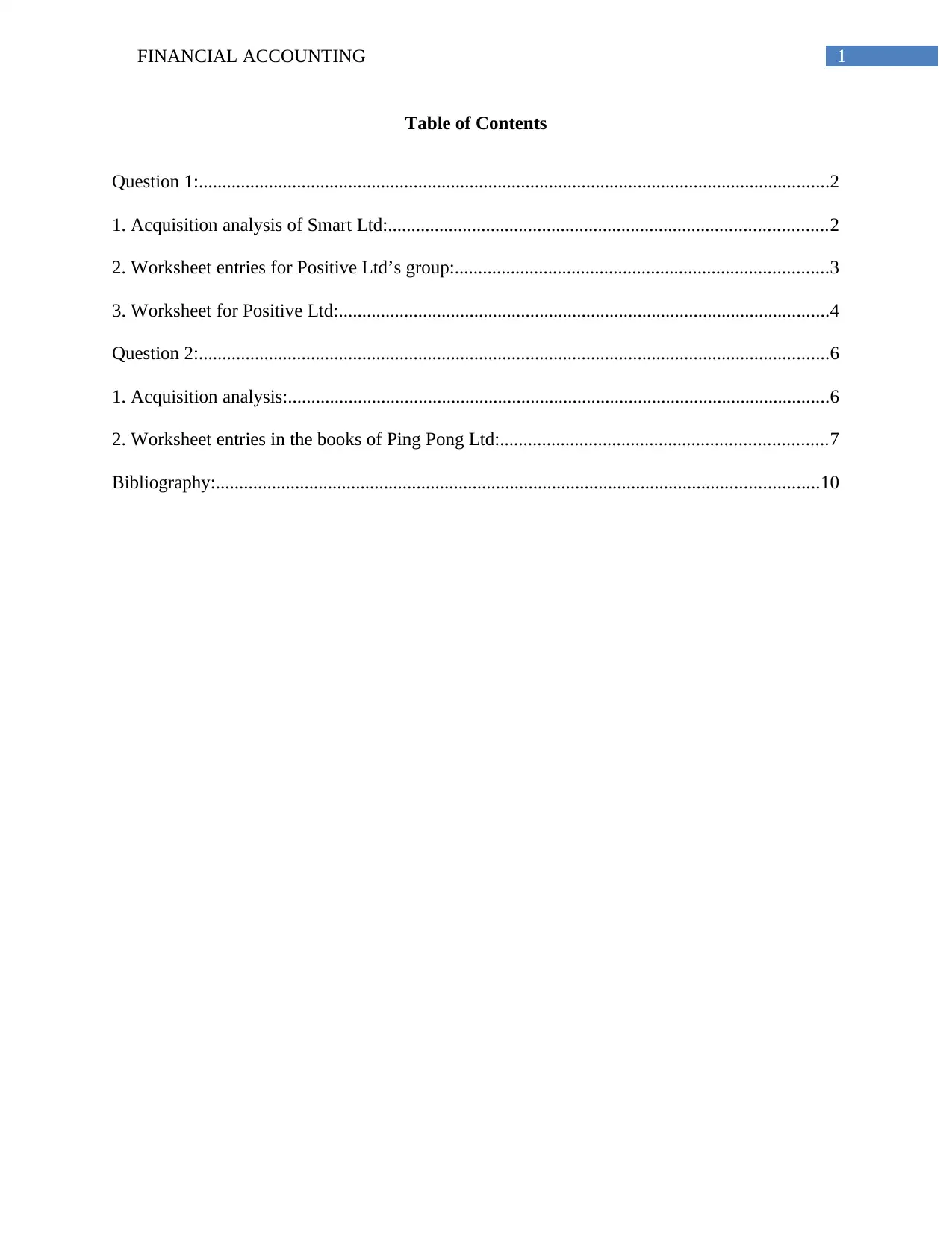
1FINANCIAL ACCOUNTING
Table of Contents
Question 1:.......................................................................................................................................2
1. Acquisition analysis of Smart Ltd:..............................................................................................2
2. Worksheet entries for Positive Ltd’s group:................................................................................3
3. Worksheet for Positive Ltd:.........................................................................................................4
Question 2:.......................................................................................................................................6
1. Acquisition analysis:....................................................................................................................6
2. Worksheet entries in the books of Ping Pong Ltd:......................................................................7
Bibliography:.................................................................................................................................10
Table of Contents
Question 1:.......................................................................................................................................2
1. Acquisition analysis of Smart Ltd:..............................................................................................2
2. Worksheet entries for Positive Ltd’s group:................................................................................3
3. Worksheet for Positive Ltd:.........................................................................................................4
Question 2:.......................................................................................................................................6
1. Acquisition analysis:....................................................................................................................6
2. Worksheet entries in the books of Ping Pong Ltd:......................................................................7
Bibliography:.................................................................................................................................10
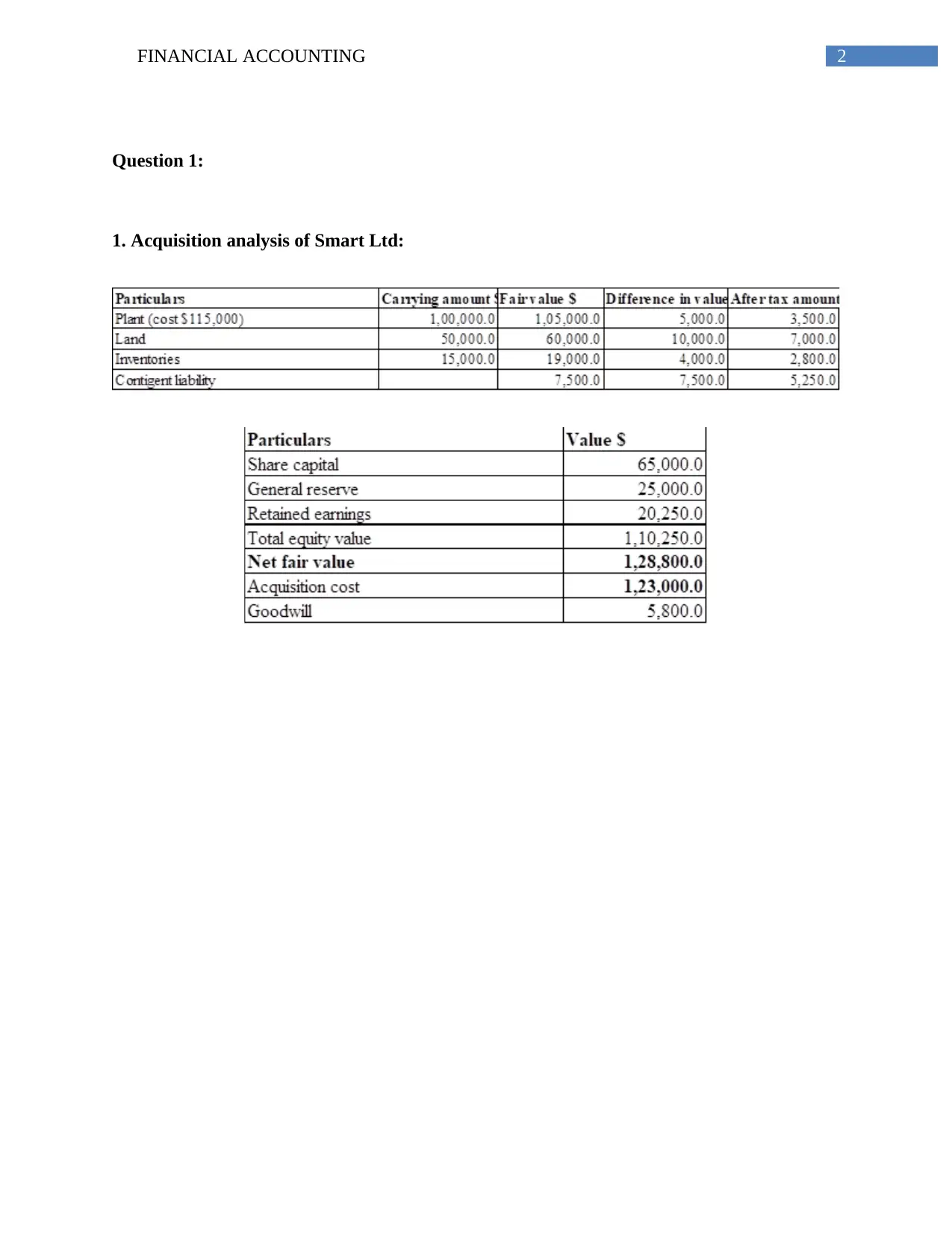
2FINANCIAL ACCOUNTING
Question 1:
1. Acquisition analysis of Smart Ltd:
Question 1:
1. Acquisition analysis of Smart Ltd:
⊘ This is a preview!⊘
Do you want full access?
Subscribe today to unlock all pages.

Trusted by 1+ million students worldwide
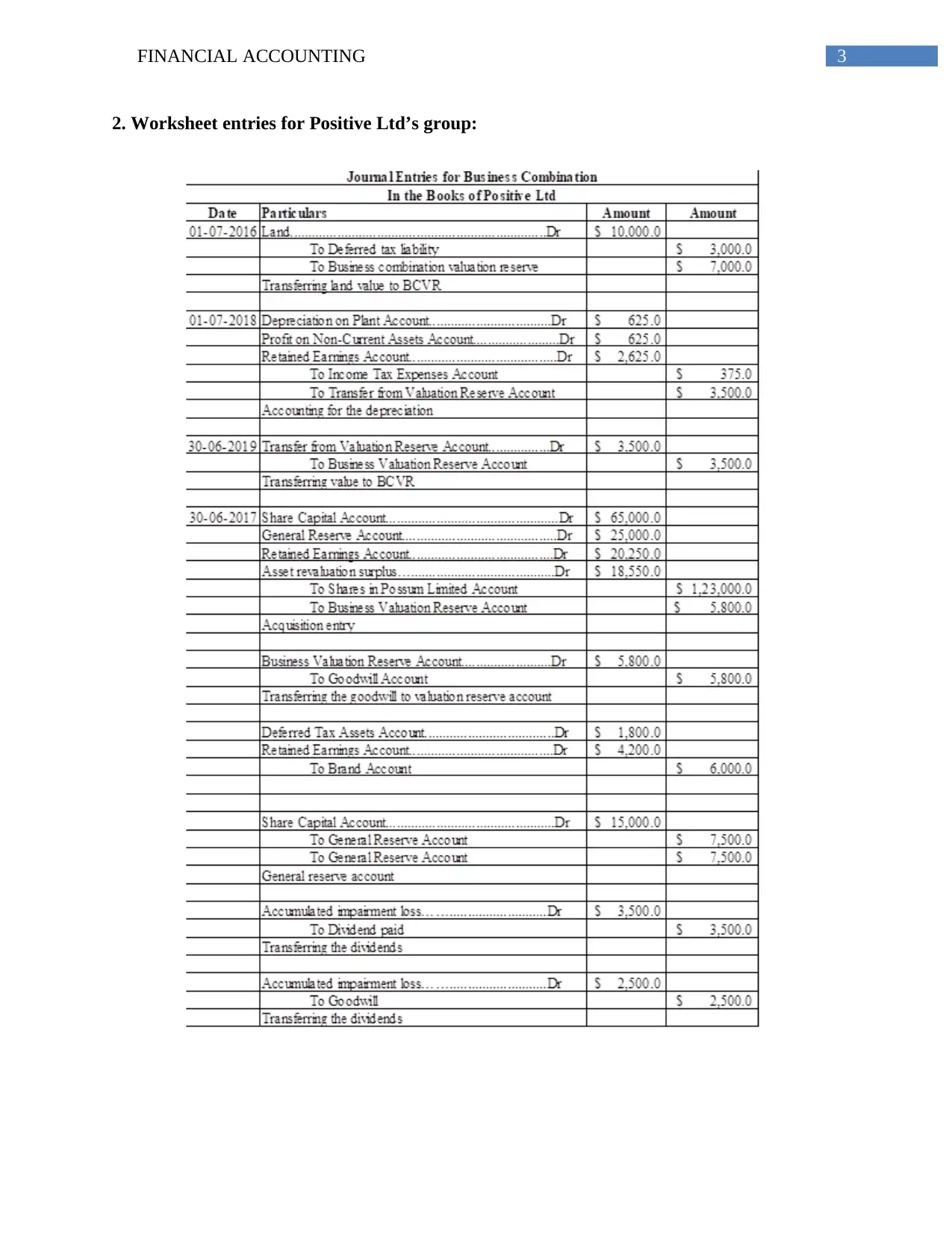
3FINANCIAL ACCOUNTING
2. Worksheet entries for Positive Ltd’s group:
2. Worksheet entries for Positive Ltd’s group:
Paraphrase This Document
Need a fresh take? Get an instant paraphrase of this document with our AI Paraphraser
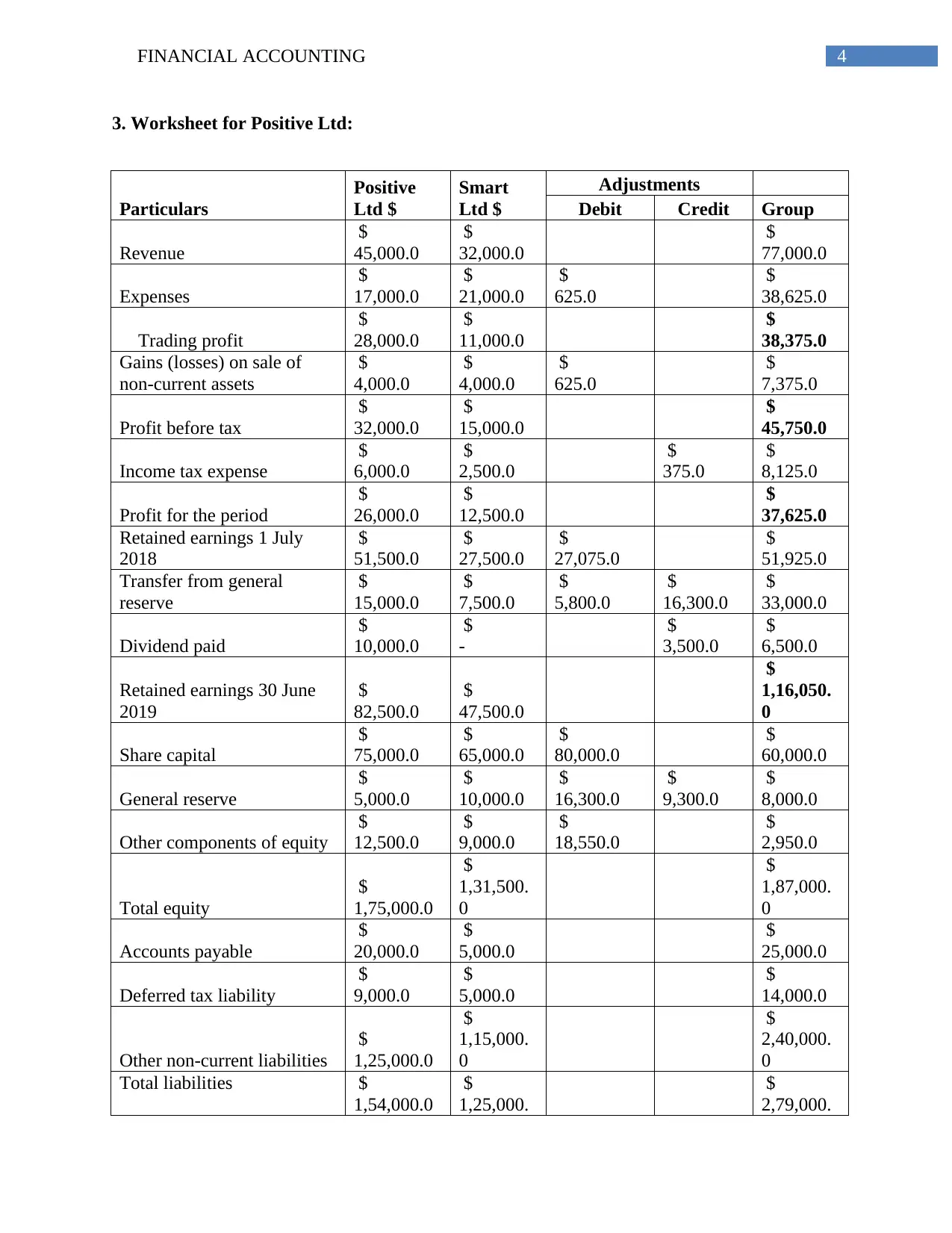
4FINANCIAL ACCOUNTING
3. Worksheet for Positive Ltd:
Particulars
Positive
Ltd $
Smart
Ltd $
Adjustments
Debit Credit Group
Revenue
$
45,000.0
$
32,000.0
$
77,000.0
Expenses
$
17,000.0
$
21,000.0
$
625.0
$
38,625.0
Trading profit
$
28,000.0
$
11,000.0
$
38,375.0
Gains (losses) on sale of
non-current assets
$
4,000.0
$
4,000.0
$
625.0
$
7,375.0
Profit before tax
$
32,000.0
$
15,000.0
$
45,750.0
Income tax expense
$
6,000.0
$
2,500.0
$
375.0
$
8,125.0
Profit for the period
$
26,000.0
$
12,500.0
$
37,625.0
Retained earnings 1 July
2018
$
51,500.0
$
27,500.0
$
27,075.0
$
51,925.0
Transfer from general
reserve
$
15,000.0
$
7,500.0
$
5,800.0
$
16,300.0
$
33,000.0
Dividend paid
$
10,000.0
$
-
$
3,500.0
$
6,500.0
Retained earnings 30 June
2019
$
82,500.0
$
47,500.0
$
1,16,050.
0
Share capital
$
75,000.0
$
65,000.0
$
80,000.0
$
60,000.0
General reserve
$
5,000.0
$
10,000.0
$
16,300.0
$
9,300.0
$
8,000.0
Other components of equity
$
12,500.0
$
9,000.0
$
18,550.0
$
2,950.0
Total equity
$
1,75,000.0
$
1,31,500.
0
$
1,87,000.
0
Accounts payable
$
20,000.0
$
5,000.0
$
25,000.0
Deferred tax liability
$
9,000.0
$
5,000.0
$
14,000.0
Other non-current liabilities
$
1,25,000.0
$
1,15,000.
0
$
2,40,000.
0
Total liabilities $
1,54,000.0
$
1,25,000.
$
2,79,000.
3. Worksheet for Positive Ltd:
Particulars
Positive
Ltd $
Smart
Ltd $
Adjustments
Debit Credit Group
Revenue
$
45,000.0
$
32,000.0
$
77,000.0
Expenses
$
17,000.0
$
21,000.0
$
625.0
$
38,625.0
Trading profit
$
28,000.0
$
11,000.0
$
38,375.0
Gains (losses) on sale of
non-current assets
$
4,000.0
$
4,000.0
$
625.0
$
7,375.0
Profit before tax
$
32,000.0
$
15,000.0
$
45,750.0
Income tax expense
$
6,000.0
$
2,500.0
$
375.0
$
8,125.0
Profit for the period
$
26,000.0
$
12,500.0
$
37,625.0
Retained earnings 1 July
2018
$
51,500.0
$
27,500.0
$
27,075.0
$
51,925.0
Transfer from general
reserve
$
15,000.0
$
7,500.0
$
5,800.0
$
16,300.0
$
33,000.0
Dividend paid
$
10,000.0
$
-
$
3,500.0
$
6,500.0
Retained earnings 30 June
2019
$
82,500.0
$
47,500.0
$
1,16,050.
0
Share capital
$
75,000.0
$
65,000.0
$
80,000.0
$
60,000.0
General reserve
$
5,000.0
$
10,000.0
$
16,300.0
$
9,300.0
$
8,000.0
Other components of equity
$
12,500.0
$
9,000.0
$
18,550.0
$
2,950.0
Total equity
$
1,75,000.0
$
1,31,500.
0
$
1,87,000.
0
Accounts payable
$
20,000.0
$
5,000.0
$
25,000.0
Deferred tax liability
$
9,000.0
$
5,000.0
$
14,000.0
Other non-current liabilities
$
1,25,000.0
$
1,15,000.
0
$
2,40,000.
0
Total liabilities $
1,54,000.0
$
1,25,000.
$
2,79,000.
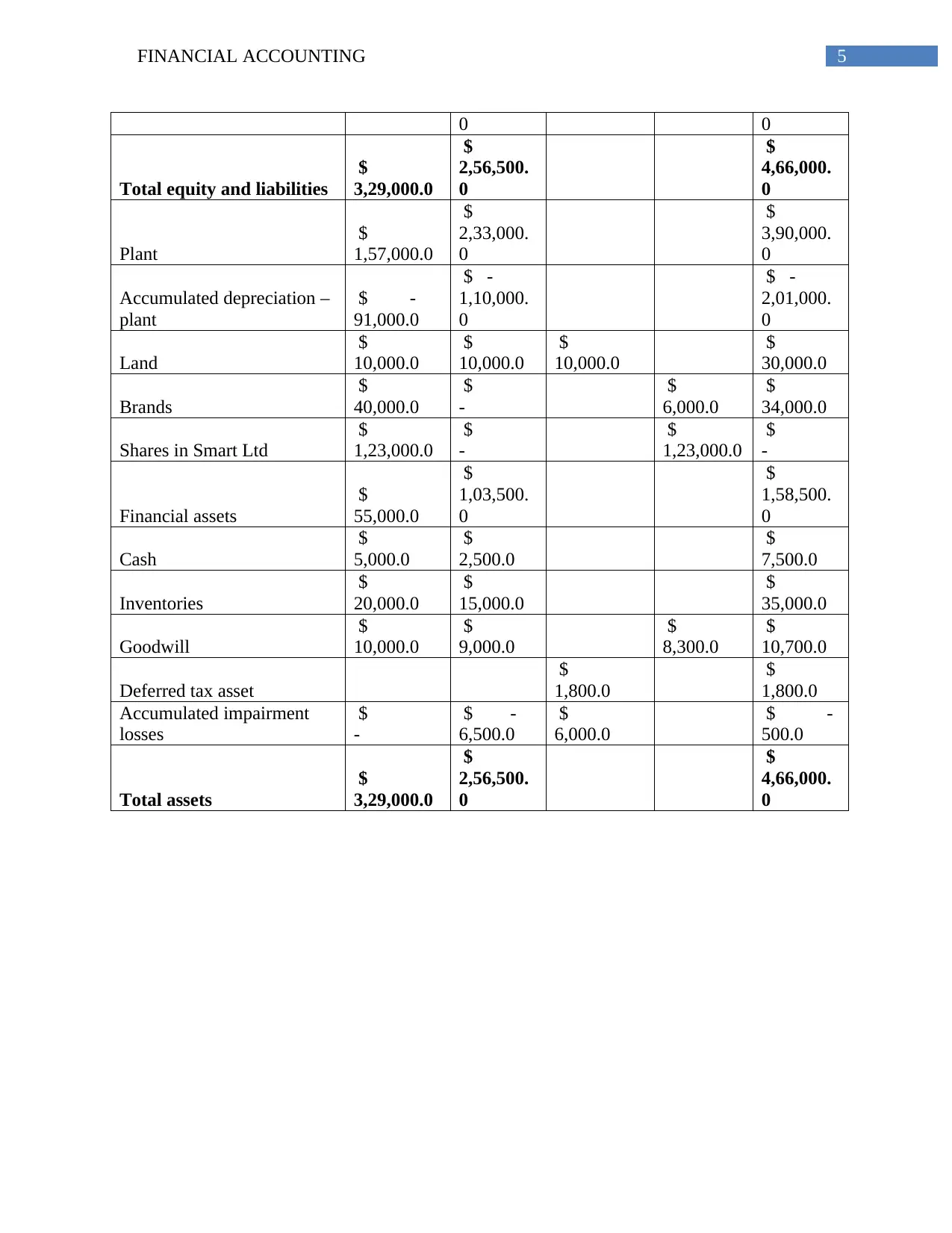
5FINANCIAL ACCOUNTING
0 0
Total equity and liabilities
$
3,29,000.0
$
2,56,500.
0
$
4,66,000.
0
Plant
$
1,57,000.0
$
2,33,000.
0
$
3,90,000.
0
Accumulated depreciation –
plant
$ -
91,000.0
$ -
1,10,000.
0
$ -
2,01,000.
0
Land
$
10,000.0
$
10,000.0
$
10,000.0
$
30,000.0
Brands
$
40,000.0
$
-
$
6,000.0
$
34,000.0
Shares in Smart Ltd
$
1,23,000.0
$
-
$
1,23,000.0
$
-
Financial assets
$
55,000.0
$
1,03,500.
0
$
1,58,500.
0
Cash
$
5,000.0
$
2,500.0
$
7,500.0
Inventories
$
20,000.0
$
15,000.0
$
35,000.0
Goodwill
$
10,000.0
$
9,000.0
$
8,300.0
$
10,700.0
Deferred tax asset
$
1,800.0
$
1,800.0
Accumulated impairment
losses
$
-
$ -
6,500.0
$
6,000.0
$ -
500.0
Total assets
$
3,29,000.0
$
2,56,500.
0
$
4,66,000.
0
0 0
Total equity and liabilities
$
3,29,000.0
$
2,56,500.
0
$
4,66,000.
0
Plant
$
1,57,000.0
$
2,33,000.
0
$
3,90,000.
0
Accumulated depreciation –
plant
$ -
91,000.0
$ -
1,10,000.
0
$ -
2,01,000.
0
Land
$
10,000.0
$
10,000.0
$
10,000.0
$
30,000.0
Brands
$
40,000.0
$
-
$
6,000.0
$
34,000.0
Shares in Smart Ltd
$
1,23,000.0
$
-
$
1,23,000.0
$
-
Financial assets
$
55,000.0
$
1,03,500.
0
$
1,58,500.
0
Cash
$
5,000.0
$
2,500.0
$
7,500.0
Inventories
$
20,000.0
$
15,000.0
$
35,000.0
Goodwill
$
10,000.0
$
9,000.0
$
8,300.0
$
10,700.0
Deferred tax asset
$
1,800.0
$
1,800.0
Accumulated impairment
losses
$
-
$ -
6,500.0
$
6,000.0
$ -
500.0
Total assets
$
3,29,000.0
$
2,56,500.
0
$
4,66,000.
0
⊘ This is a preview!⊘
Do you want full access?
Subscribe today to unlock all pages.

Trusted by 1+ million students worldwide
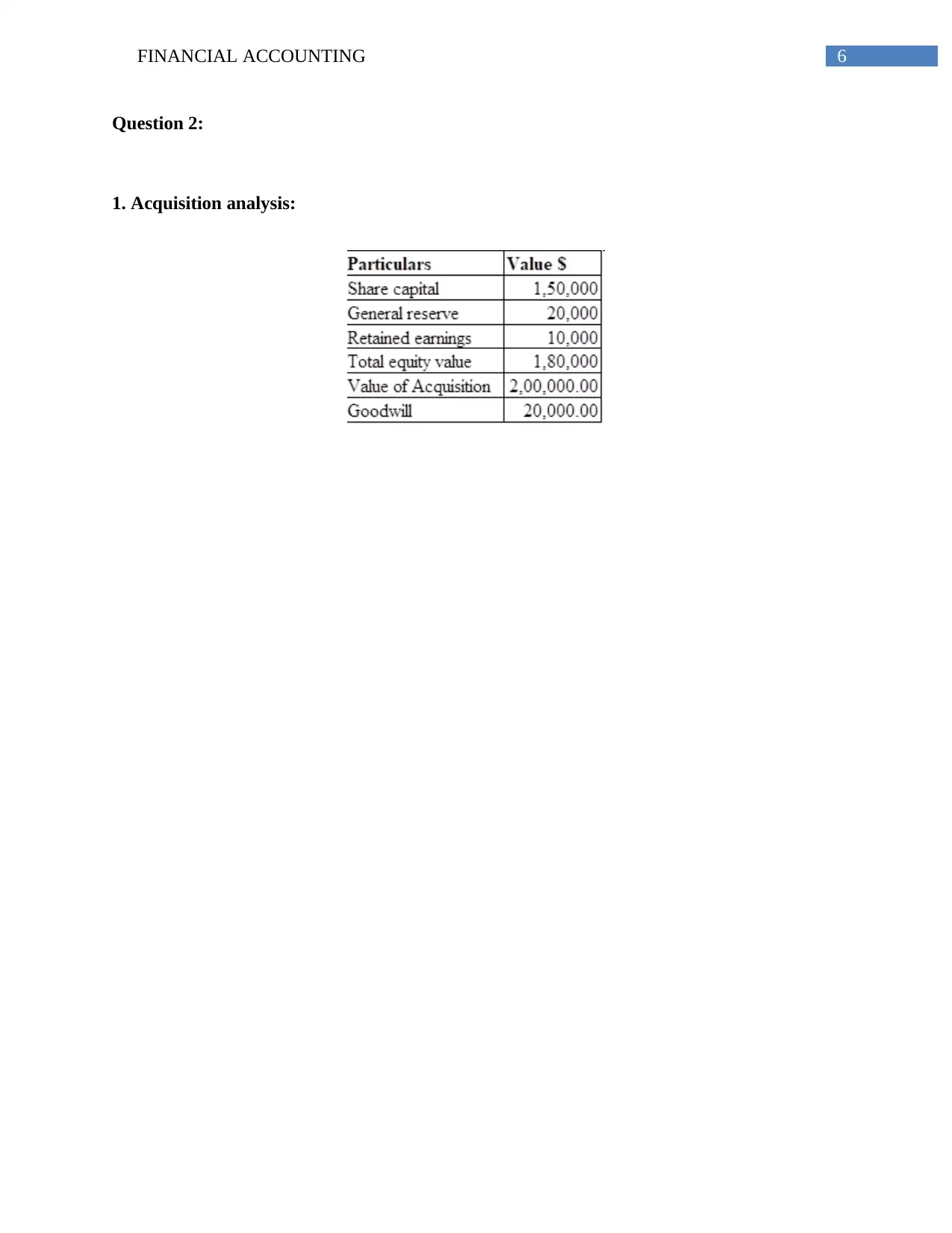
6FINANCIAL ACCOUNTING
Question 2:
1. Acquisition analysis:
Question 2:
1. Acquisition analysis:
Paraphrase This Document
Need a fresh take? Get an instant paraphrase of this document with our AI Paraphraser
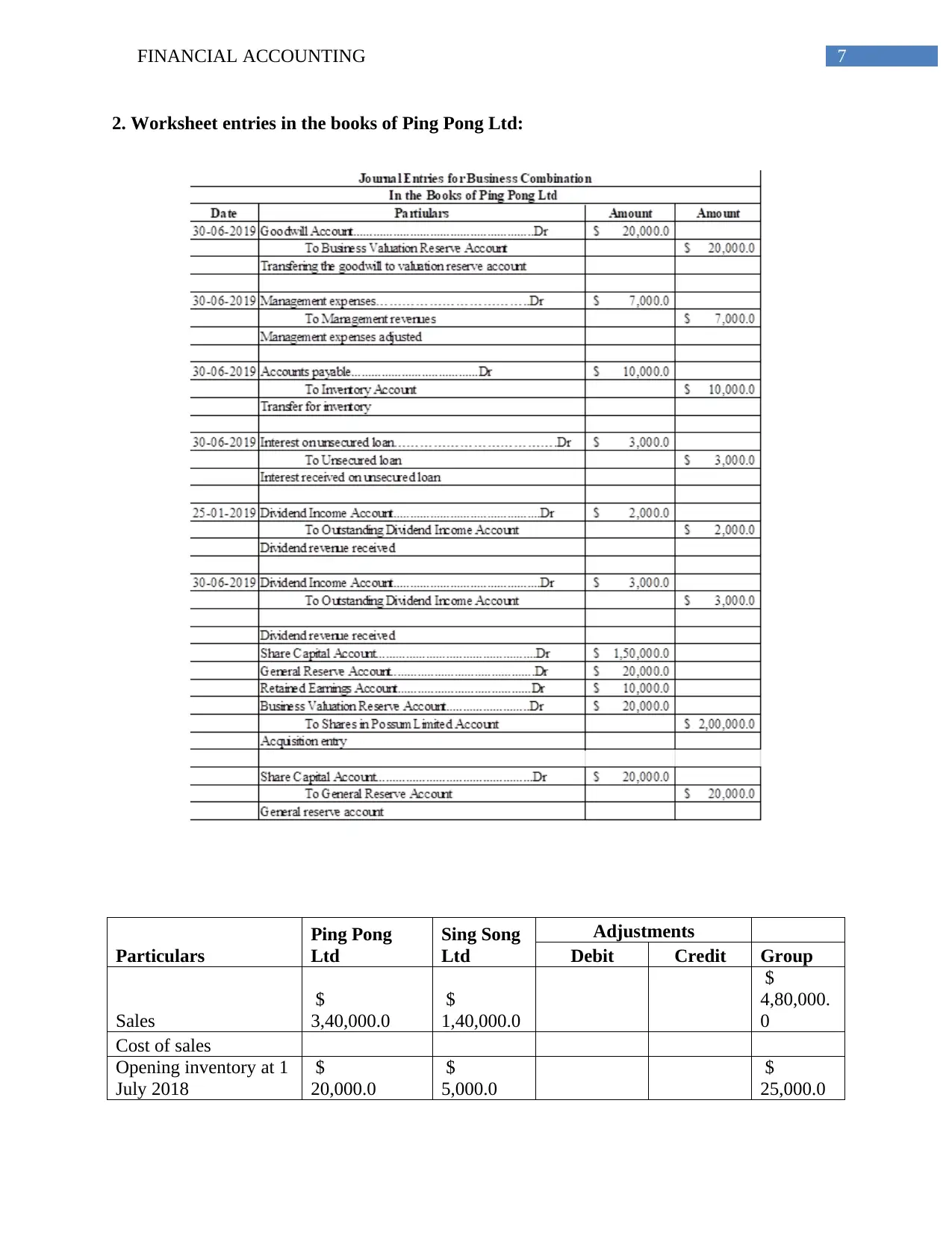
7FINANCIAL ACCOUNTING
2. Worksheet entries in the books of Ping Pong Ltd:
Particulars
Ping Pong
Ltd
Sing Song
Ltd
Adjustments
Debit Credit Group
Sales
$
3,40,000.0
$
1,40,000.0
$
4,80,000.
0
Cost of sales
Opening inventory at 1
July 2018
$
20,000.0
$
5,000.0
$
25,000.0
2. Worksheet entries in the books of Ping Pong Ltd:
Particulars
Ping Pong
Ltd
Sing Song
Ltd
Adjustments
Debit Credit Group
Sales
$
3,40,000.0
$
1,40,000.0
$
4,80,000.
0
Cost of sales
Opening inventory at 1
July 2018
$
20,000.0
$
5,000.0
$
25,000.0
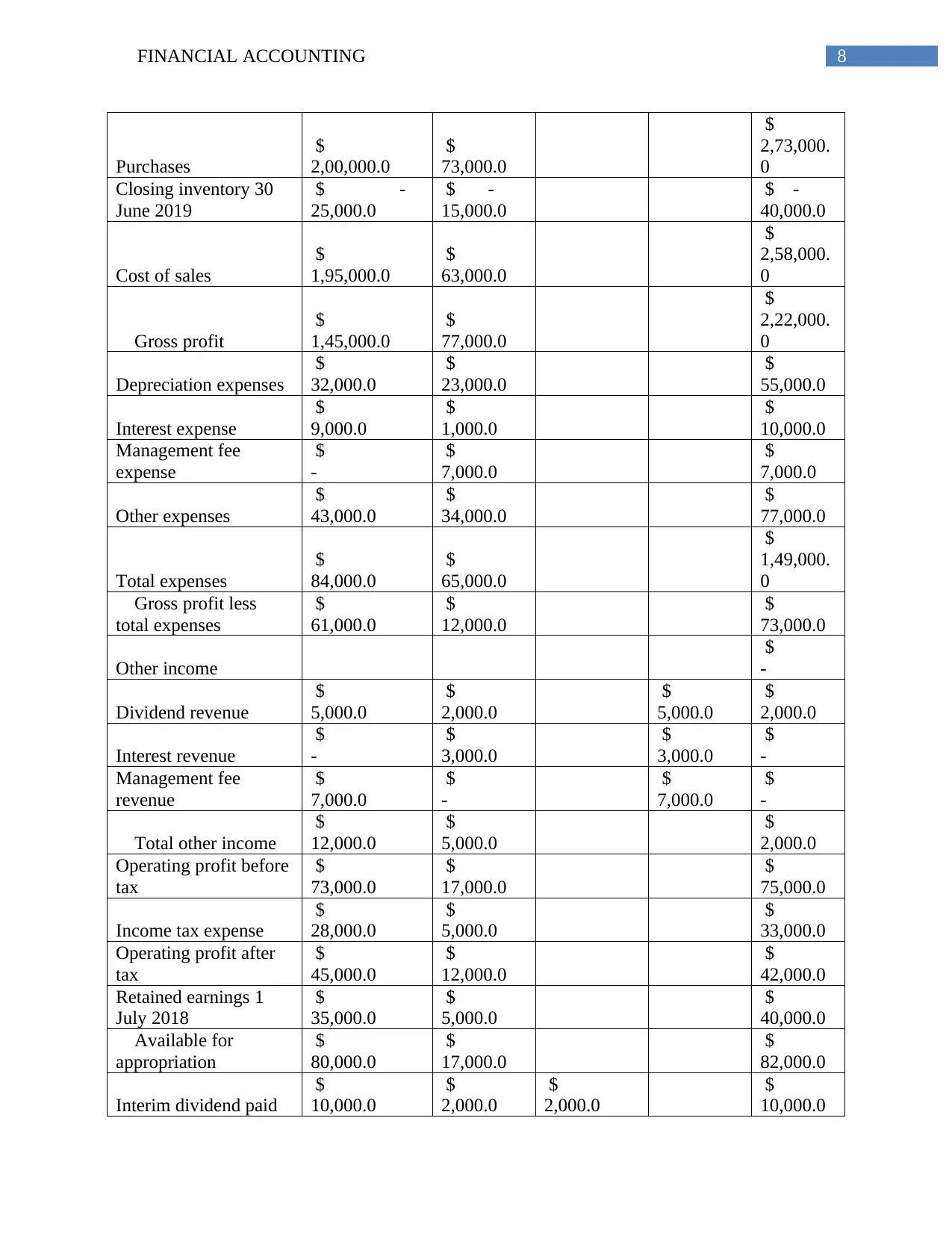
8FINANCIAL ACCOUNTING
Purchases
$
2,00,000.0
$
73,000.0
$
2,73,000.
0
Closing inventory 30
June 2019
$ -
25,000.0
$ -
15,000.0
$ -
40,000.0
Cost of sales
$
1,95,000.0
$
63,000.0
$
2,58,000.
0
Gross profit
$
1,45,000.0
$
77,000.0
$
2,22,000.
0
Depreciation expenses
$
32,000.0
$
23,000.0
$
55,000.0
Interest expense
$
9,000.0
$
1,000.0
$
10,000.0
Management fee
expense
$
-
$
7,000.0
$
7,000.0
Other expenses
$
43,000.0
$
34,000.0
$
77,000.0
Total expenses
$
84,000.0
$
65,000.0
$
1,49,000.
0
Gross profit less
total expenses
$
61,000.0
$
12,000.0
$
73,000.0
Other income
$
-
Dividend revenue
$
5,000.0
$
2,000.0
$
5,000.0
$
2,000.0
Interest revenue
$
-
$
3,000.0
$
3,000.0
$
-
Management fee
revenue
$
7,000.0
$
-
$
7,000.0
$
-
Total other income
$
12,000.0
$
5,000.0
$
2,000.0
Operating profit before
tax
$
73,000.0
$
17,000.0
$
75,000.0
Income tax expense
$
28,000.0
$
5,000.0
$
33,000.0
Operating profit after
tax
$
45,000.0
$
12,000.0
$
42,000.0
Retained earnings 1
July 2018
$
35,000.0
$
5,000.0
$
40,000.0
Available for
appropriation
$
80,000.0
$
17,000.0
$
82,000.0
Interim dividend paid
$
10,000.0
$
2,000.0
$
2,000.0
$
10,000.0
Purchases
$
2,00,000.0
$
73,000.0
$
2,73,000.
0
Closing inventory 30
June 2019
$ -
25,000.0
$ -
15,000.0
$ -
40,000.0
Cost of sales
$
1,95,000.0
$
63,000.0
$
2,58,000.
0
Gross profit
$
1,45,000.0
$
77,000.0
$
2,22,000.
0
Depreciation expenses
$
32,000.0
$
23,000.0
$
55,000.0
Interest expense
$
9,000.0
$
1,000.0
$
10,000.0
Management fee
expense
$
-
$
7,000.0
$
7,000.0
Other expenses
$
43,000.0
$
34,000.0
$
77,000.0
Total expenses
$
84,000.0
$
65,000.0
$
1,49,000.
0
Gross profit less
total expenses
$
61,000.0
$
12,000.0
$
73,000.0
Other income
$
-
Dividend revenue
$
5,000.0
$
2,000.0
$
5,000.0
$
2,000.0
Interest revenue
$
-
$
3,000.0
$
3,000.0
$
-
Management fee
revenue
$
7,000.0
$
-
$
7,000.0
$
-
Total other income
$
12,000.0
$
5,000.0
$
2,000.0
Operating profit before
tax
$
73,000.0
$
17,000.0
$
75,000.0
Income tax expense
$
28,000.0
$
5,000.0
$
33,000.0
Operating profit after
tax
$
45,000.0
$
12,000.0
$
42,000.0
Retained earnings 1
July 2018
$
35,000.0
$
5,000.0
$
40,000.0
Available for
appropriation
$
80,000.0
$
17,000.0
$
82,000.0
Interim dividend paid
$
10,000.0
$
2,000.0
$
2,000.0
$
10,000.0
⊘ This is a preview!⊘
Do you want full access?
Subscribe today to unlock all pages.

Trusted by 1+ million students worldwide
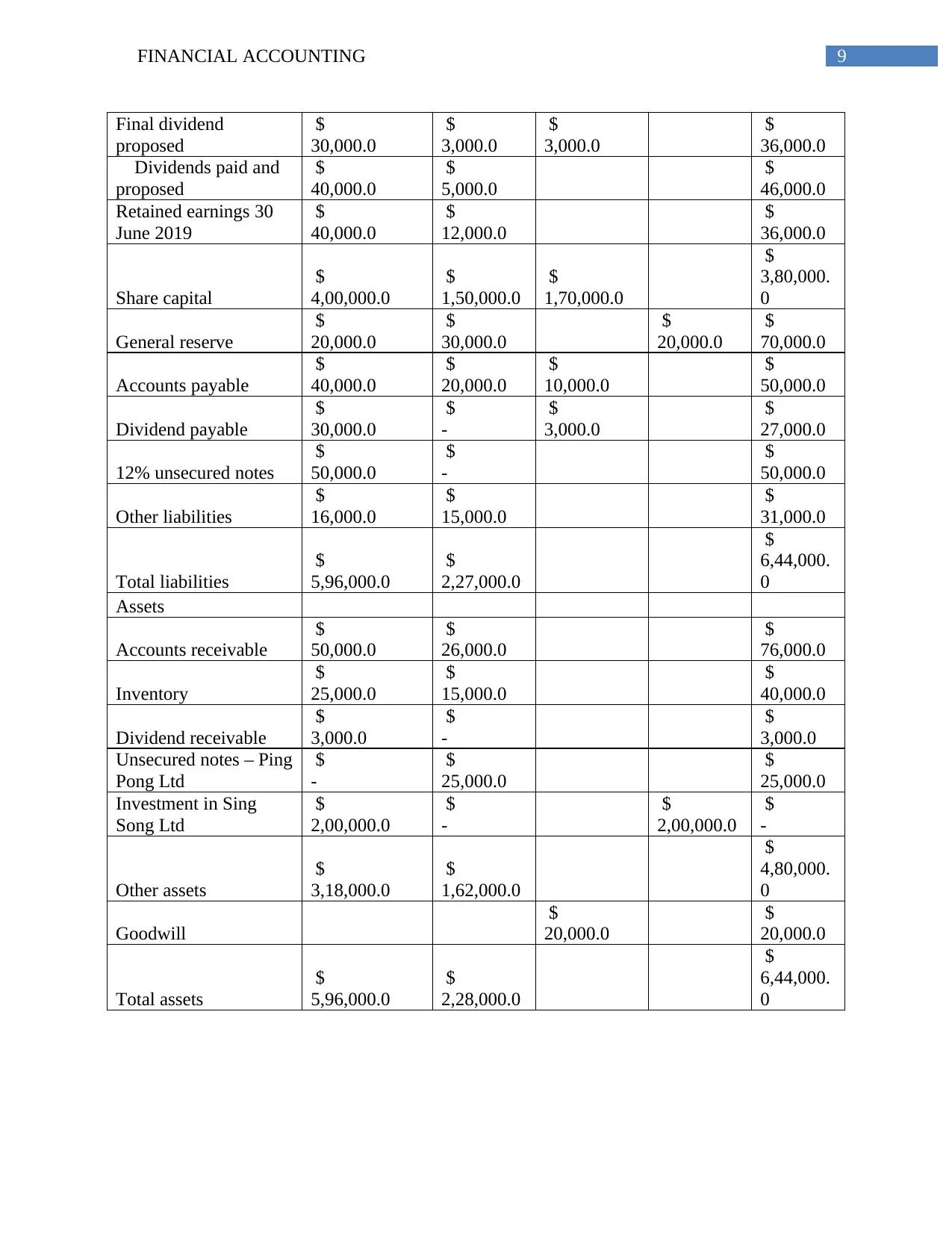
9FINANCIAL ACCOUNTING
Final dividend
proposed
$
30,000.0
$
3,000.0
$
3,000.0
$
36,000.0
Dividends paid and
proposed
$
40,000.0
$
5,000.0
$
46,000.0
Retained earnings 30
June 2019
$
40,000.0
$
12,000.0
$
36,000.0
Share capital
$
4,00,000.0
$
1,50,000.0
$
1,70,000.0
$
3,80,000.
0
General reserve
$
20,000.0
$
30,000.0
$
20,000.0
$
70,000.0
Accounts payable
$
40,000.0
$
20,000.0
$
10,000.0
$
50,000.0
Dividend payable
$
30,000.0
$
-
$
3,000.0
$
27,000.0
12% unsecured notes
$
50,000.0
$
-
$
50,000.0
Other liabilities
$
16,000.0
$
15,000.0
$
31,000.0
Total liabilities
$
5,96,000.0
$
2,27,000.0
$
6,44,000.
0
Assets
Accounts receivable
$
50,000.0
$
26,000.0
$
76,000.0
Inventory
$
25,000.0
$
15,000.0
$
40,000.0
Dividend receivable
$
3,000.0
$
-
$
3,000.0
Unsecured notes – Ping
Pong Ltd
$
-
$
25,000.0
$
25,000.0
Investment in Sing
Song Ltd
$
2,00,000.0
$
-
$
2,00,000.0
$
-
Other assets
$
3,18,000.0
$
1,62,000.0
$
4,80,000.
0
Goodwill
$
20,000.0
$
20,000.0
Total assets
$
5,96,000.0
$
2,28,000.0
$
6,44,000.
0
Final dividend
proposed
$
30,000.0
$
3,000.0
$
3,000.0
$
36,000.0
Dividends paid and
proposed
$
40,000.0
$
5,000.0
$
46,000.0
Retained earnings 30
June 2019
$
40,000.0
$
12,000.0
$
36,000.0
Share capital
$
4,00,000.0
$
1,50,000.0
$
1,70,000.0
$
3,80,000.
0
General reserve
$
20,000.0
$
30,000.0
$
20,000.0
$
70,000.0
Accounts payable
$
40,000.0
$
20,000.0
$
10,000.0
$
50,000.0
Dividend payable
$
30,000.0
$
-
$
3,000.0
$
27,000.0
12% unsecured notes
$
50,000.0
$
-
$
50,000.0
Other liabilities
$
16,000.0
$
15,000.0
$
31,000.0
Total liabilities
$
5,96,000.0
$
2,27,000.0
$
6,44,000.
0
Assets
Accounts receivable
$
50,000.0
$
26,000.0
$
76,000.0
Inventory
$
25,000.0
$
15,000.0
$
40,000.0
Dividend receivable
$
3,000.0
$
-
$
3,000.0
Unsecured notes – Ping
Pong Ltd
$
-
$
25,000.0
$
25,000.0
Investment in Sing
Song Ltd
$
2,00,000.0
$
-
$
2,00,000.0
$
-
Other assets
$
3,18,000.0
$
1,62,000.0
$
4,80,000.
0
Goodwill
$
20,000.0
$
20,000.0
Total assets
$
5,96,000.0
$
2,28,000.0
$
6,44,000.
0
Paraphrase This Document
Need a fresh take? Get an instant paraphrase of this document with our AI Paraphraser
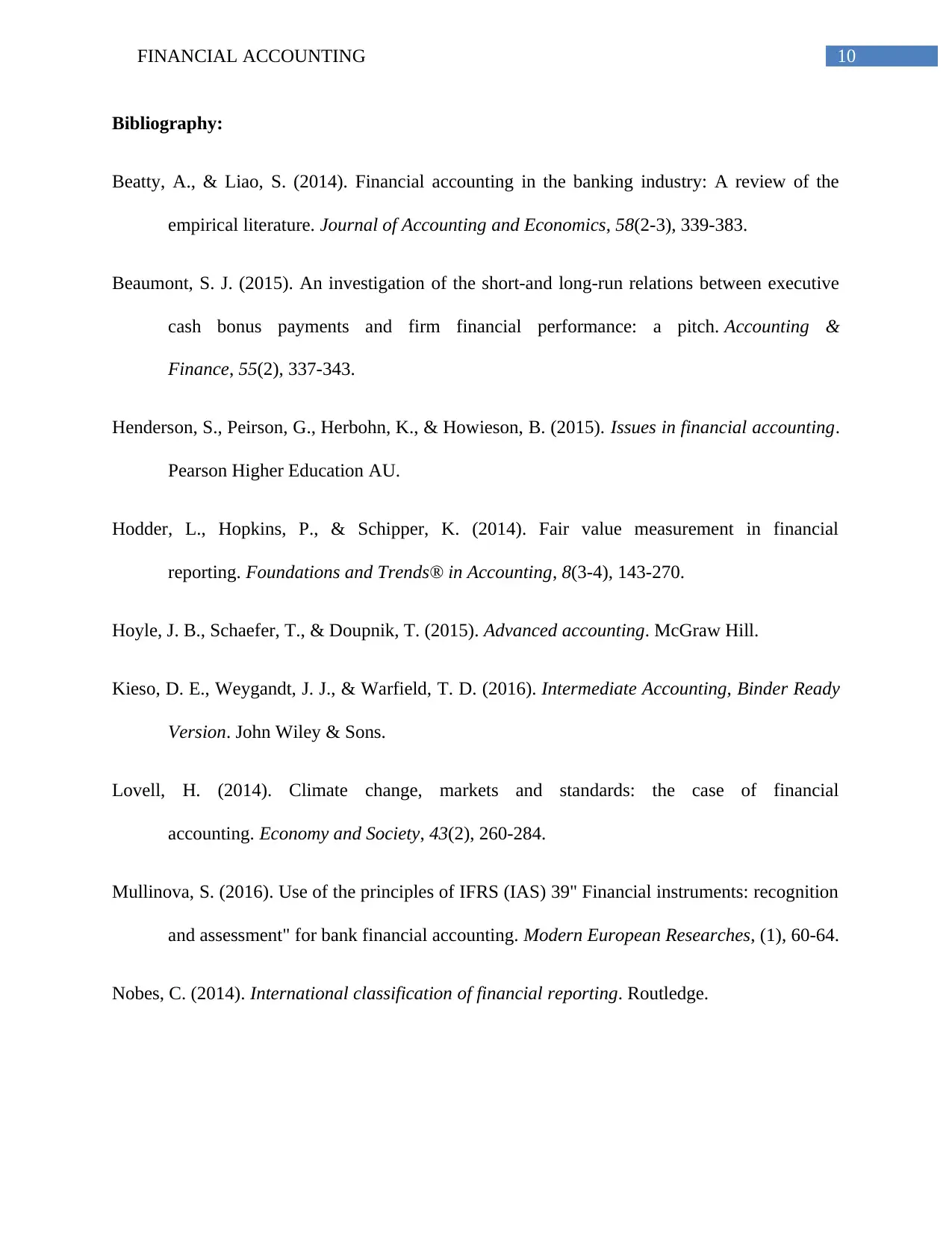
10FINANCIAL ACCOUNTING
Bibliography:
Beatty, A., & Liao, S. (2014). Financial accounting in the banking industry: A review of the
empirical literature. Journal of Accounting and Economics, 58(2-3), 339-383.
Beaumont, S. J. (2015). An investigation of the short‐and long‐run relations between executive
cash bonus payments and firm financial performance: a pitch. Accounting &
Finance, 55(2), 337-343.
Henderson, S., Peirson, G., Herbohn, K., & Howieson, B. (2015). Issues in financial accounting.
Pearson Higher Education AU.
Hodder, L., Hopkins, P., & Schipper, K. (2014). Fair value measurement in financial
reporting. Foundations and Trends® in Accounting, 8(3-4), 143-270.
Hoyle, J. B., Schaefer, T., & Doupnik, T. (2015). Advanced accounting. McGraw Hill.
Kieso, D. E., Weygandt, J. J., & Warfield, T. D. (2016). Intermediate Accounting, Binder Ready
Version. John Wiley & Sons.
Lovell, H. (2014). Climate change, markets and standards: the case of financial
accounting. Economy and Society, 43(2), 260-284.
Mullinova, S. (2016). Use of the principles of IFRS (IAS) 39" Financial instruments: recognition
and assessment" for bank financial accounting. Modern European Researches, (1), 60-64.
Nobes, C. (2014). International classification of financial reporting. Routledge.
Bibliography:
Beatty, A., & Liao, S. (2014). Financial accounting in the banking industry: A review of the
empirical literature. Journal of Accounting and Economics, 58(2-3), 339-383.
Beaumont, S. J. (2015). An investigation of the short‐and long‐run relations between executive
cash bonus payments and firm financial performance: a pitch. Accounting &
Finance, 55(2), 337-343.
Henderson, S., Peirson, G., Herbohn, K., & Howieson, B. (2015). Issues in financial accounting.
Pearson Higher Education AU.
Hodder, L., Hopkins, P., & Schipper, K. (2014). Fair value measurement in financial
reporting. Foundations and Trends® in Accounting, 8(3-4), 143-270.
Hoyle, J. B., Schaefer, T., & Doupnik, T. (2015). Advanced accounting. McGraw Hill.
Kieso, D. E., Weygandt, J. J., & Warfield, T. D. (2016). Intermediate Accounting, Binder Ready
Version. John Wiley & Sons.
Lovell, H. (2014). Climate change, markets and standards: the case of financial
accounting. Economy and Society, 43(2), 260-284.
Mullinova, S. (2016). Use of the principles of IFRS (IAS) 39" Financial instruments: recognition
and assessment" for bank financial accounting. Modern European Researches, (1), 60-64.
Nobes, C. (2014). International classification of financial reporting. Routledge.
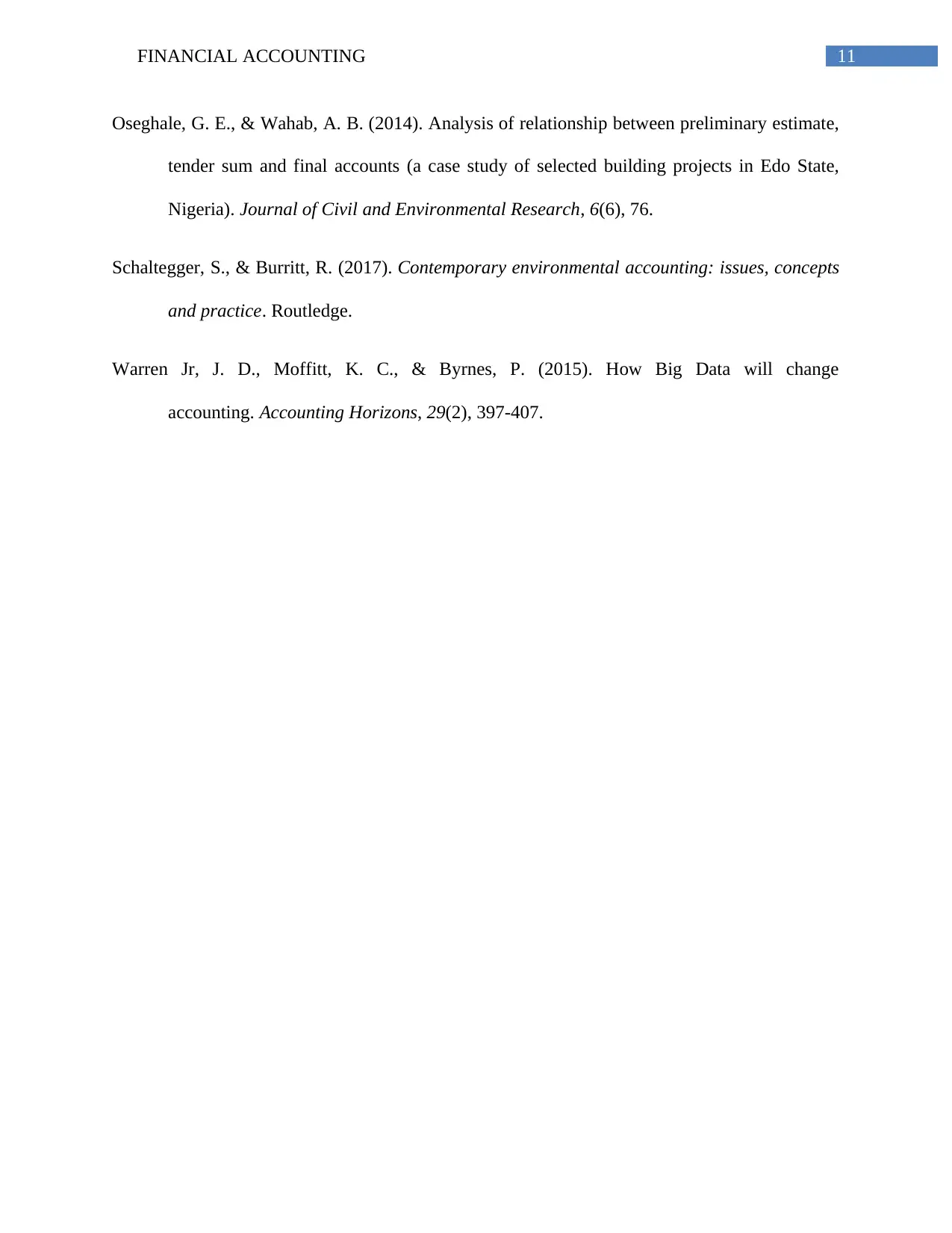
11FINANCIAL ACCOUNTING
Oseghale, G. E., & Wahab, A. B. (2014). Analysis of relationship between preliminary estimate,
tender sum and final accounts (a case study of selected building projects in Edo State,
Nigeria). Journal of Civil and Environmental Research, 6(6), 76.
Schaltegger, S., & Burritt, R. (2017). Contemporary environmental accounting: issues, concepts
and practice. Routledge.
Warren Jr, J. D., Moffitt, K. C., & Byrnes, P. (2015). How Big Data will change
accounting. Accounting Horizons, 29(2), 397-407.
Oseghale, G. E., & Wahab, A. B. (2014). Analysis of relationship between preliminary estimate,
tender sum and final accounts (a case study of selected building projects in Edo State,
Nigeria). Journal of Civil and Environmental Research, 6(6), 76.
Schaltegger, S., & Burritt, R. (2017). Contemporary environmental accounting: issues, concepts
and practice. Routledge.
Warren Jr, J. D., Moffitt, K. C., & Byrnes, P. (2015). How Big Data will change
accounting. Accounting Horizons, 29(2), 397-407.
⊘ This is a preview!⊘
Do you want full access?
Subscribe today to unlock all pages.

Trusted by 1+ million students worldwide
1 out of 12
Related Documents
Your All-in-One AI-Powered Toolkit for Academic Success.
+13062052269
info@desklib.com
Available 24*7 on WhatsApp / Email
![[object Object]](/_next/static/media/star-bottom.7253800d.svg)
Unlock your academic potential
Copyright © 2020–2025 A2Z Services. All Rights Reserved. Developed and managed by ZUCOL.




